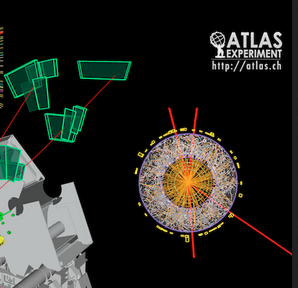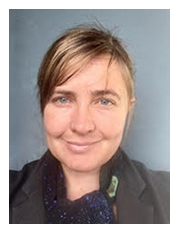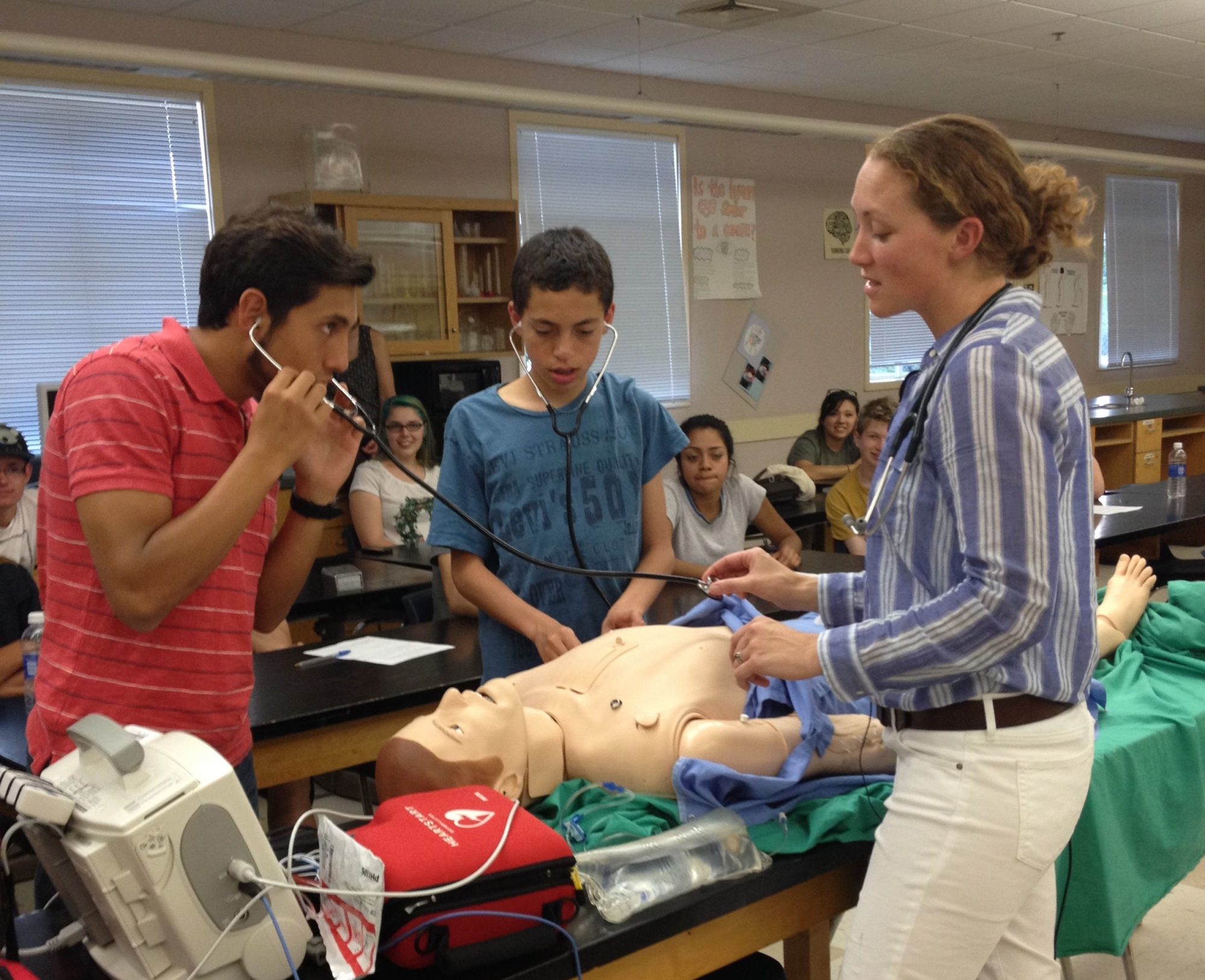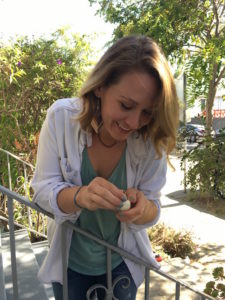by Talya Klinger, MSS Intern
Dr. Amber Sciligo, a scientist in the department of Environmental Science, Policy, and Management at UC Berkeley, researches the interactions between insects, plants, the environment, and human economies. Whether she directs her focus to examining self-fertilizing carnivorous plants, observing how native bee communities enhance crop pollination, or finding the optimal level of crop diversity for sustainable farming, Dr. Sciligo’s research has important implications for the wild world of botany. Attend her research presentation at Terra Linda High School, Room 207, from 7:30-8:30 pm on October 21st.
In Dr. Sciligo’s words:
–>
1. How did you originally get interested in ecology and evolution?
Multiple life events led me down this path. The first was in my high school biology class, when I was taught how to catch insects and curate them as if they were to be kept in a museum (arrange their body parts and pin them so that they would dry out and be preserved). I LOVED it. I thought I would become an entomology museum curator. By the time I entered college though, I had changed my interests and thought I would save the dolphins (this was back in the 90s) and signed up for the marine biology major at UCSC. Then I took a scuba class in my sophomore year and damaged my ears. I realized my place was probably not underwater, so I changed my major to Ecology and Evolution, a new major that had the same prerequisites as marine biology. That’s when I took another entomology class, curated insects again, and was reminded how much I loved them! So from then on, I took classes that allowed me to specialize in the ecology and evolution of plant-insect interactions. And the rest is history.
2. Why did you decide to research sundew plants?
I kind of fell into the study system. Normally, one picks a study system to ask a research question. In this case I had my question in mind (is there pollinator-prey conflict in carnivorous plants in New Zealand and how do they deal with it?) without more than a vague idea of where I would conduct the work. I knew I wanted to study carnivorous plants and to ask this question. I knew that I wanted to go to graduate school in New Zealand. And when I put the two together, I landed on the system of Drosera (sundews), because it was the only feasible carnivorous plant that New Zealand had to offer. At the time, I didn’t realize that Australia, just a hop, skip and a jump away, had close to 200 species of carnivorous plants of many types, while NZ only had 12 species of two types. But I had chosen NZ, so sundews are what I got!
3. How do carnivorous plants satisfy their needs for insect pollinators and insects as food at the same time?
They do a pretty incredible job attracting different kinds of insects to their traps and to their flowers, usually by visual cues such as colors, or by emitting different smells from the traps and flowers. Often, smaller insects like ants and tiny flies will get trapped as prey, which provides the plants with the nutrients they need. Larger flies and bees will visit the flowers to provide pollination. Sometimes pollinators get trapped as prey. Maybe they were visiting the flowers and the trap was too close and the pollinators fall in or get tangled up. This can be bad for the plant if they need that pollinator to bring pollen from another flower in order to make seeds. But if the plant doesn’t need this, if it can self-fertilize without many inbreeding consequences, then catching a big juicy pollinator would provide a great feed for the plant.
4. What impact will your research on crop diversification and bee communities have on agriculture?
My current work is looking not just at how crop diversity improves native bee communities, (which is an important finding on its own as it demonstrates a way to leave land in production and support biodiversity at the same time), but also how crop diversity and other practices such as crop rotation, cover cropping, mixing annual and perennial crops, and planting flower strips or hedgerows affect multiple ecosystem services at once, e.g. pollination, natural pest control, and soil and air quality. This allows us to see whether farming techniques that improve biodiversity on a farm provides benefits or tradeoffs to ecosystem services (e.g. plants that attract pollinators might also attract pests, but then they might also attract natural predators of those pests). Farmers don’t think about each of these things independently, they see their farms as a whole system with pests and pollinators, and birds and everything else all interacting at once. So it’s important that if we are going to conduct research that results in management recommendations, then we need to study the farm as a whole too. Otherwise we might make conservation recommendations that are unfeasible and won’t be adopted.
5. What’s your advice for high school students who are passionate about ecology and environmental science?
Find what aspects about these fields specifically interest you and dive in! If you have a more broad interest then seek out as many opportunities as you can to expose yourself to multiple aspects of these fields (there are many) and run with those that bring you the most curiosity and excitement. Volunteer to teach younger children or other community members. Teaching is the best way to learn about something. And look for opportunities to work in research labs at universities. There you can learn what parts of the scientific process you like the most. And maybe you’ll find a system that really fascinates you and you can end up studying that for a senior thesis project at a university, or on your own if you prefer.
I would add that while the scientific research world needs enthusiastic students like you, there are many important roles for people who love the natural world: scientific research is one way to go, teaching in schools or public forums is another, or sharing your values through writing, painting, song or other artistic avenues is also a great way to inspire others around you to pay attention.
6. One last question: do you have a favorite carnivorous plant?
Well, to be honest, I’m not really familiar with too many species. In NZ, there are only 12 species and most of them are really, really small and easy to miss. For instance, my study species ranged from only 1/2”-4” in height. I always wanted to find Drosera pygmaea, whose sticky-trap rosette is only 0.25” in diameter!! It’s no wonder I never found them though…they are so small.
I am also fascinated by the bladderworts (Utricularia spp.). They too are very small and were also at my study sites. You can only spot them when they send out a tiny flowering stalk from the body of water in which they reside. The traps are underwater and act like a vacuum to catch tiny swimming insects. I don’t know how they manage to lure the insects into their little bladders, which is why I find them so interesting. They also have very pretty flowers of bright colors, which is not characteristic of the sundews.
 Title: “The Higgs Boson” with Dr. Heather Gray of UC Berkeley
Title: “The Higgs Boson” with Dr. Heather Gray of UC Berkeley


 Title: “Redwoods, Roots, and Fungi: Exploring Plant Physiology and Ecology” with Claire Willing of UC Berkeley
Title: “Redwoods, Roots, and Fungi: Exploring Plant Physiology and Ecology” with Claire Willing of UC Berkeley








